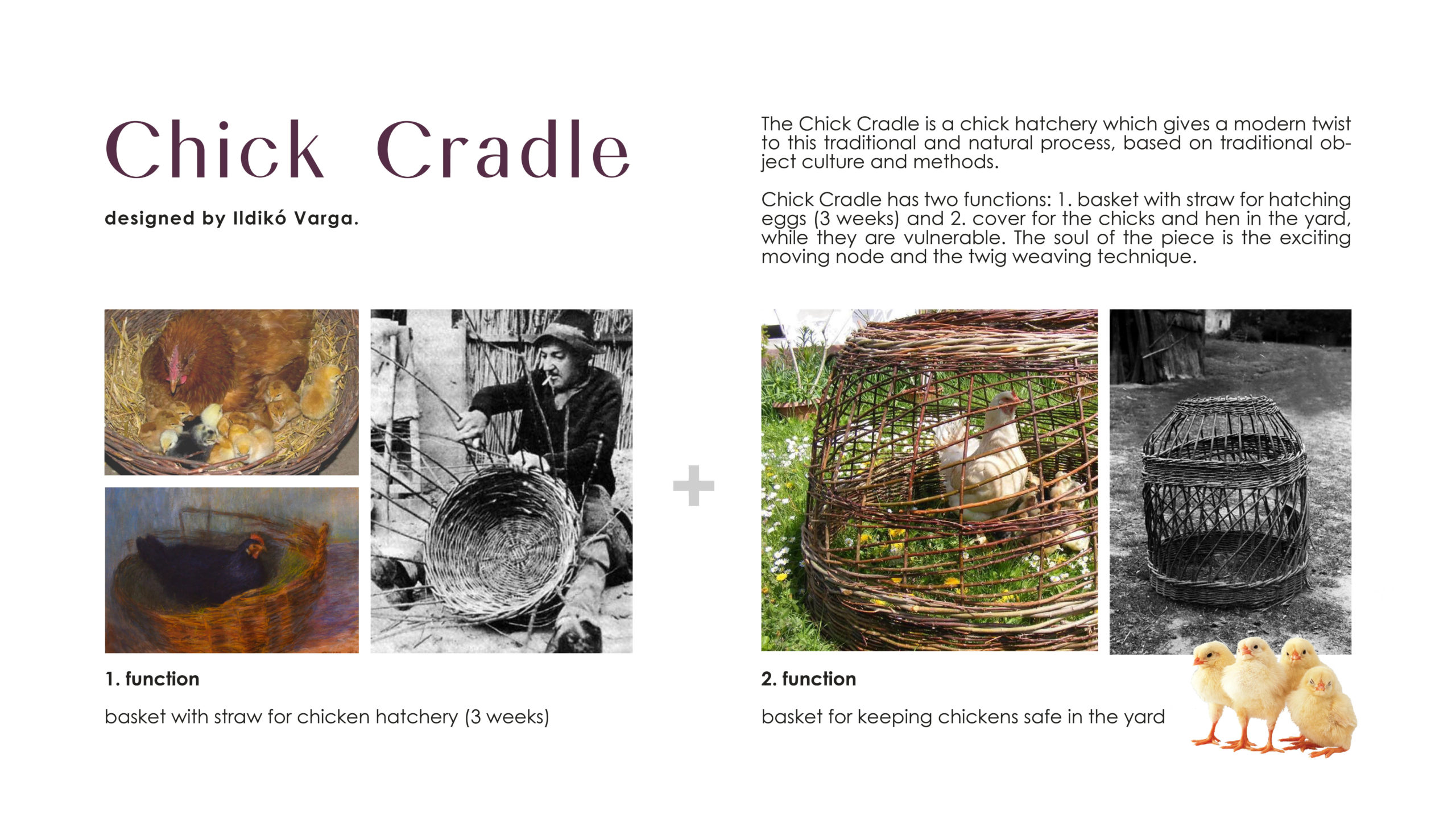Chick Cradle

Useful information
- Team members
- Ildikó Varga
- Country
- Hungary
- Keywords
- Chicken hatchery quality vs quantity meat production
Short Description
The Chick Cradle is a chick hatchery with a modern twist to this traditional and natural process.
Detailed Description
The Chick Cradle is a different approach to chicken hatchery, based on traditional object culture and
methods. The piece intends to raise questions around the concept of meat mass production vs small-
scale chicken farming and the relationship between people and farm animals. The Chick Cradle’s filigree
metal frame gives it an industrial feel, which is contrasted by the twist of traditional twig weaving. The
Chick Cradle has two functions: 1. basket with straw for hatching eggs (3 weeks) and 2. cover for the
chicks and hen in the yard, while they are vulnerable. The soul of the piece is the exciting moving node.
It can turn back into itself, thus being able to fulfill both functions – of the basket and of the cover.
This project was born in Moholy-Nagy University of Art and Design Budapest.
Project Details
- Does your design take social and cultural challenges and human wellbeing into consideration?
1. Preserving local values
The Chick Cradle represents the traditional and humane approach to chicken hatchery, which is
disappearing in today’s modern world. The product’s functions were inspired by Hungarian object
culture and methods, which I want to preserve. It was important to I integrate the technique of twig
weaving, so the result reflects on local values. Thanks to the node it becomes a dynamic and
multifunctional object.
2. Quality vs. quantity
The aim of the Chick Cradle is to be a well-functioning object that facilitates domestic chicken
husbandry. It emphasizes the importance of the small local producers and juxtaposes them with
industrial meat producers. I believe that it is important to promote the quality over the quantity of
poultry consumption.3. Humans and animals
The Chick Cradle wants to raise awareness of animals’ living conditions. Farm animals also have the right
to decent conditions, which is compromised by the industrial meat producers. The Chick Cradle is one
way to support local producers.
- Does your design support sustainable production, embodying circular or regenerative design practices?
The Chick Cradle is sustainable and part of circular economy for several reasons:
1. Recyclable and biodegradable materials
The Chick Cradle is made of two materials: homogenic metal and twig. The metal is reusable,
and the twig is a biodegradable local material. The twig is usable only for weaving and is not
applicable to other technologies.
2. Local materials
It is important that I work with locally sourced materials.
3. Long lifecycleOne of the best approaches of sustainability is designing durable, easy to maintain and long-
lasting products. Maintainability and a strong frame are part of the Chick Cradle’s concept. Thiscan serve several generations.
4. Multifunctionality
This product serves two functions: hatching the eggs and providing shelter to the chicks. This
means having to buy only one product instead of two.
- Does your design use principles of distribution and open source?
The Chick Cradle’s technical drawing and description is going to be available online.
- Does your design promote awareness of responsible design and consumption?
All aspects of Chick Cradle emphasizes the role of responsible designer. Firstly, a duty of preserving local
values is fulfilled. Secondly, it is important that we think along the lines of sustainability, focusing on
reusability, degradability, and long lifecycle. Chick Cradle represents these principles.
Beyond its perfect functionality, the Chick Cradle’s mission is to encourage the small producers to step
up in the face of industrial meat producers and draw attention to humane animal husbandry.
Images


